Why Every Excel User Needs Microsoft 365
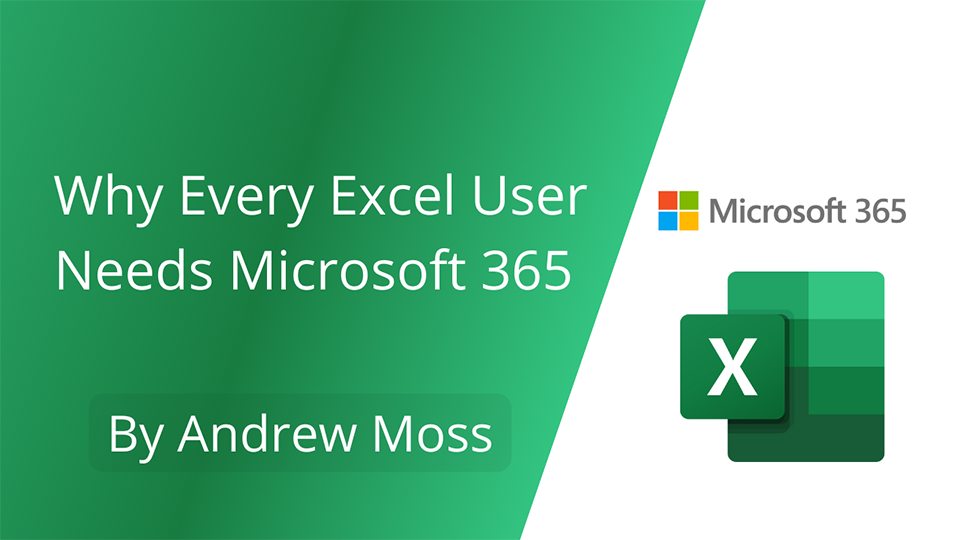
Still got that old copy of Excel installed?
Uninstall it, bin it (if it’s a CD-ROM), and get with the times.
STOP being an Excel dinosaur!
You’re Missing Out on the Updates
You may not be aware, but unless you have a Microsoft 365 subscription, you will not receive any updates (apart from security patches).
That means if you own a perpetual version of Office or any specific program, you are stuck with it. You miss out on all the exciting new tweaks, features and functions Microsoft is rolling out.
In the past, it was a viable excuse to say you couldn’t see the point of upgrading — and you would have been right.
In the space of nine years, there was Excel 2016, Excel 2013, Excel 2010 and Excel 2007. We waited three years between each, but nothing really changed. Sure, there were a few minor additions, but not a lot for the average user to be swayed by. No wonder people didn’t bother.
Today, however, the reasons to upgrade are overwhelming. And it doesn’t matter what your profession is — whether you are an accountant, data analyst, financial analyst, administrator, or student.
My advice is relevant to every Excel user.
Excel Version Usage
Microsoft MVP, Danielle Stein Fairhurst, conducted a poll recently that asked LinkedIn users which version of Excel they use.
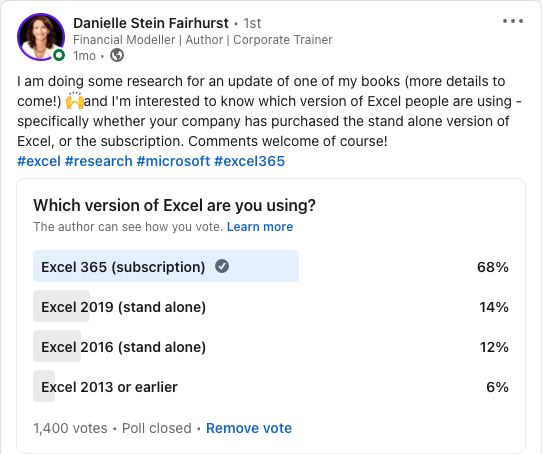
Based on 1,400 votes, 68% voted for Excel 365 (Microsoft 365), whilst a sizable 32% minority signalled they use a perpetual version.
Now, of course, there are several variables you have to take into consideration. We don’t know who the respondents were or whether they voted based on the version they use at home or the workplace. But I’d like to think it gives us an overall idea of the usage statistics in 2021.
There’s no harm in rerunning this poll, so I’ve replicated it in Microsoft Forms.
Please click here or on the image below to be taken to it, and after 1,400 votes it will be interesting to see how the results compare with Danielle’s.
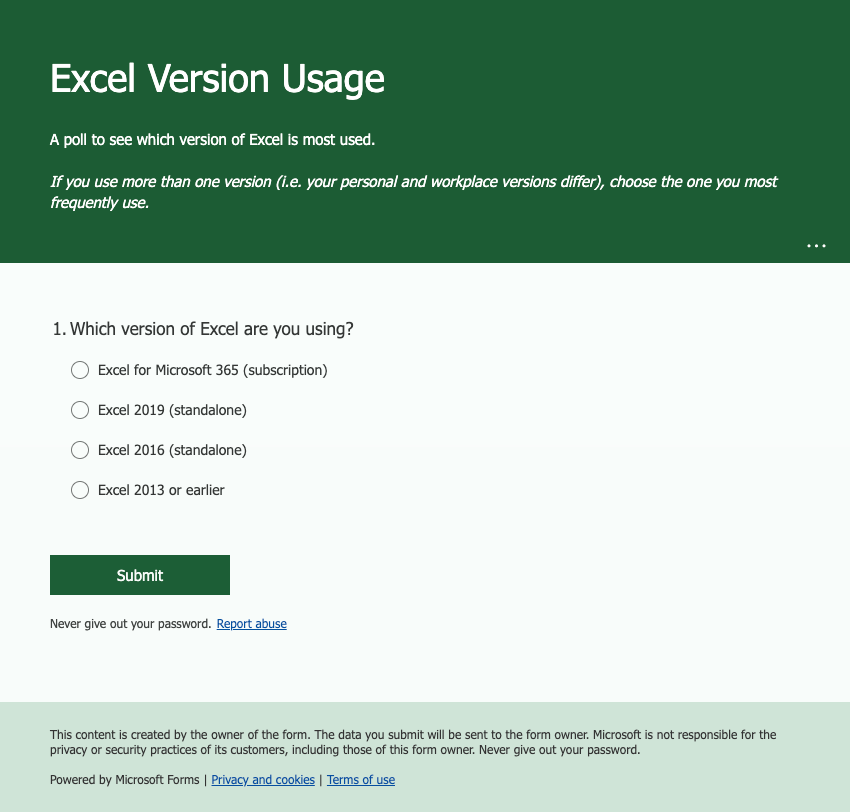
What Are Your Options?

There are four main categories for Microsoft 365 editions: home, business, enterprise and education.
I understand people’s situations vary. Some of you will work for large companies so are likely to have already been given an enterprise Microsoft 365 license you can use on your home computer. Or you may work at a small company where you don’t get this luxury.
Irrespective of this, I am recommending you purchase a subscription of your own so you have full control and can store all your personal files on OneDrive without limitations.
Let’s look at a comparison of the home options (GBP and USD included):
For a Personal Microsoft 365 license, it’s £59.99/$69.99 per year.
This equates to:
- £59.99 ÷ 365 days ≈ £0.16 per day
$69.99 ÷ 365 days ≈ $0.19 per day - £59.99 ÷ 52 weeks ≈ £1.15 per week
$69.99 ÷ 52 weeks ≈ $1.35 per week - £59.99 ÷ 12 months ≈ £5.00 per month
$69.99 ÷ 12 months ≈ $5.83 per month
If you have multiple people in your household, it might be better value to opt for the Family version, which costs £79.99/$99.99 per year.
This equates to:
- £79.99 ÷ 365 days ≈ £0.22 per day
$99.99 ÷ 365 days ≈ $0.27 per day - £79.99 ÷ 52 weeks ≈ £1.54 per week
$99.99 ÷ 52 weeks ≈ $1.92 per week - £79.99 ÷ 12 months = £6.67 per month
$99.99 ÷ 12 months = $8.33 per month
For both, the following desktop apps are included:
‣ Excel
‣ Word
‣ PowerPoint
‣ Outlook
‣ OneNote
‣ Access
‣ Publisher
In the Personal plan, you’ll receive 1TB of OneDrive space to store your documents and other files in the cloud. The Family plan entitles each person to the same amount (up to six users).
For Those Who Insist on the Perpetual Version…
A quick look on the website and you’ll realise how low priority the Office Home & Business 2019 suite is. Housed in a slim panel and nestled away at the bottom out of sight, it’s clear they have no interest in promoting it.

Clicking on the Buy now button immediately takes you to the checkout where you discover it costs a whopping £249.99/$249.99.

How many years’ worth of Personal subscriptions is £249.99/$249.99?
£249.99 ÷ £59.99 ≈ 4 years
$249.99 ÷ $69.99 ≈ 3 ½ years
In the main table above it, Office Home & Student 2019 is displayed alongside two far more alluring options. £119.99/$119.99 is a lot cheaper than the cost of Home & Business, but it’s easy to be uninspired when you look at its near-empty column.
How many years is this one worth?
£119.99 ÷ £59.99 ≈ 2 years
$119.99 ÷ $69.99 ≈ 1¾ years
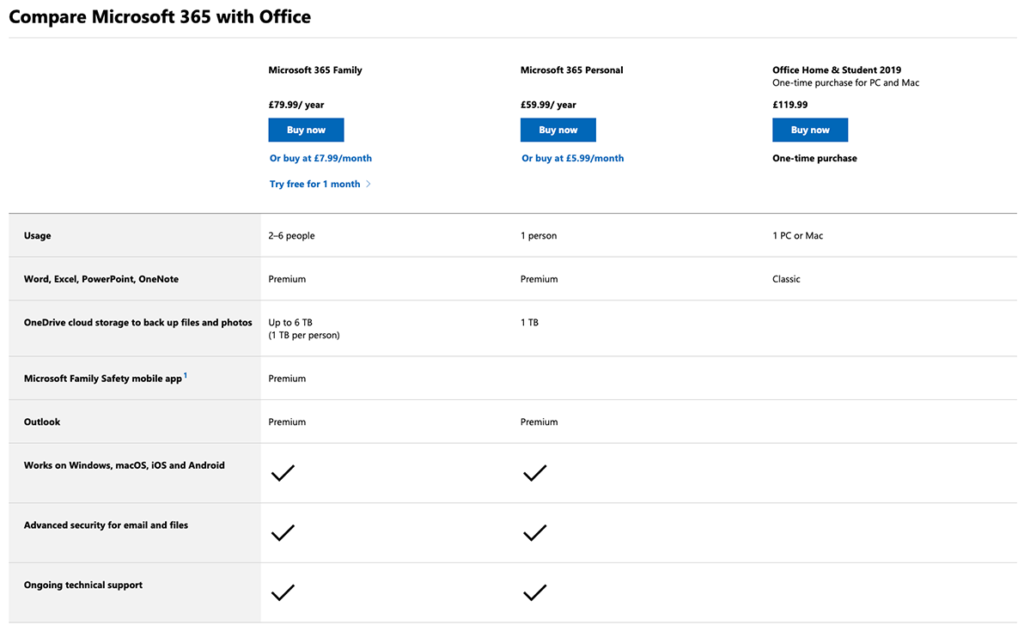
“Yet Another Subscription?”

I feel you. I don’t like this modern-day subscription culture either. It’s almost unavoidable though, as so many digital products have gone down this route.
Some subscriptions annoy me more than others though. For instance, I gave up with the macOS/iOS Fantastical calendar app because I could not justify paying £4.99/$4.99 a month or £39.99/$39.99 a year.
What the hell can you keep adding to a calendar app to make the recurring cost worth it? Come on man!
For a subscription to be justified, it’s got to be something that keeps me coming back. Word, PowerPoint, Outlook and OneNote are worth paying for as a batch, but out of all the products, Excel is the eternal beast that doesn’t know when it’s beaten.
I’d probably pay £59.99 a year for Excel alone, but as it is, having the whole Office suite along with OneDrive does offer tremendous value.
Although I own a MacBook Pro, iPhone and iPad, I am very much ingrained in the Microsoft ecosystem — software-wise.
2½ years ago I made the switch from iCloud to OneDrive as my main file storage platform. Moreover, Outlook took over from Airmail as my email client, and OneNote replaced Evernote as my note-taking app.
I haven’t looked back.
Running Windows 10 as a Parallels virtual machine is vital for my workflow. And you guessed it — it’s predominantly for one reason: Office — especially Excel.
Anyone who has used Excel for Mac knows it is a watered-down version of its Windows counterpart. Whilst the gap has narrowed, its ribbon is still different, there are missing features, and it only offers a cut-back VBA editor. There is no Power Query or Power Pivot either.
What Is the Point of Office 2022?
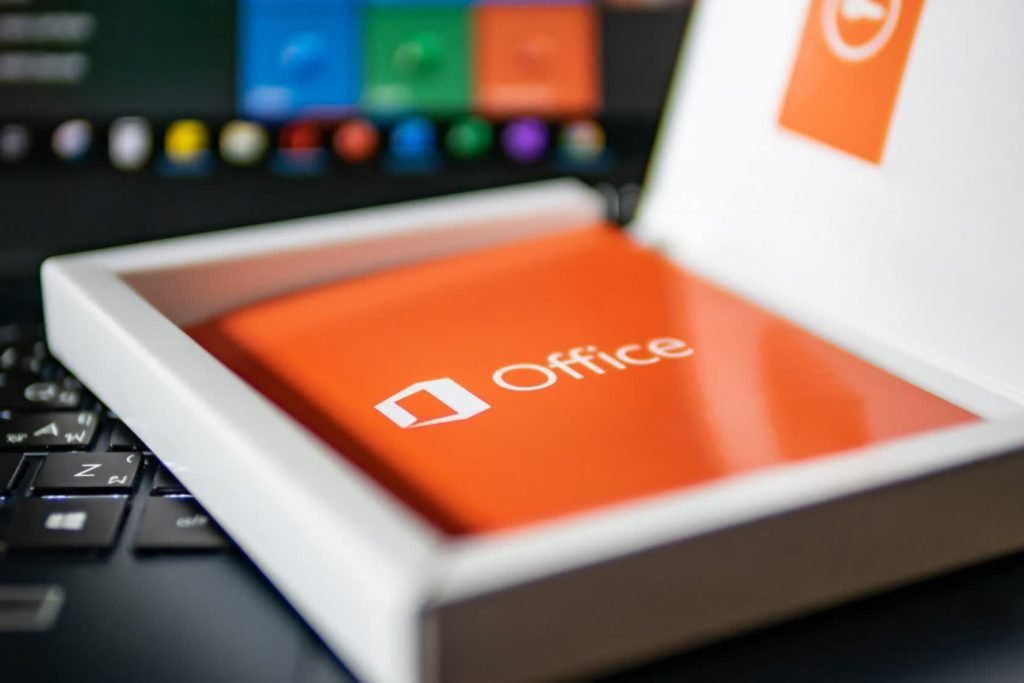
In September 2020, Microsoft announced plans to release Office 2022 later this year. When I read the news, I thought to myself: why?
Surely it’s time to get everyone on the same page by moving to a subscription-only model. What will happen now is you’ll get a certain amount of people who will purchase this, with the thought they won’t have to upgrade again for the next 10 years. Further down the line, it will be harder to convince them to get a Microsoft 365 subscription when they have already shelled out good money.
It’s a game of cat and mouse though; it will always be playing catchup. The worst thing for these users is having to wait three years for every update Microsoft rolls out to subscribers. And that’s if they’re even continuing with perpetual licenses then. I suspect they won’t be.
In any case, Office 2022’s Excel version will still have the new calculation engine and functions that have appeared over the past couple of years. But there will be omissions, such as the nascent LAMBDA function on the horizon and a host of other future additions, too.
The Future Is Excel

By sticking with your perpetual Excel copy, you’re avoiding being part of a program that is continually improving. Do you want to stand still or move forward?
Many people in the business environment who use Excel as part of their job, don’t know much more than the basics. They can use the SUM function, do a VLOOKUP, generate a chart and apply conditional formatting, but not much else.
Empirical evidence tells me the majority of Excel users are still creating and editing spreadsheets using the same practices as 15 years ago.
Considering research found that 88% of Excel spreadsheets have errors, it’s clear something’s got to change.
Thankfully, the dynamic array calculation engine has reshaped the landscape of spreadsheets and standards are starting to change, albeit slowly.
Dying away are the days of having a gazillion formulas strewn across a single worksheet. The one-formula–one-cell method is being replaced by the more efficient one-formula–many-cells approach — also known as spilled formulas.
Functions like XLOOKUP, FILTER, UNIQUE, SORT, SORTBY and SEQUENCE provide great possibilities with how you can deal with data. They can also drastically save time compared to older methods, which typically involve writing long, windy elongated formulas.
Along with new functions, Power Query and Power Pivot will continue to see updates, and these are two tools that are definitely underused at companies.
You’ll also have the opportunity to become an Office Insider, so you can test out beta versions of Excel and gain access to new features before they’re released!
For more information on dynamic arrays, check out these resources:
Dynamic array formulas in Excel | Exceljet
Dynamic array formulas and spilled array behavior — Office Support
Final Words
It’s frustrating for Excel developers to curtail their methods for the sake of compatibility, just to suit those with out-of-date versions.
I have to be honest: I’ve almost given up catering for these kinds of people. There are just too many stellar new features and functions now that prioritising compatibility isn’t in my remit anymore. If you are still using Excel 2007 and expect people to go out of their way for you — I’m sorry — that’s your problem.
I’ve worked for clients over the past couple of years and had this exact scenario. Their old version of Excel makes my life harder as I’ve got to deploy archaic and cumbersome methods to ensure everything works for them.
Please. Just do the honourable thing and buy a Microsoft 365 subscription.
